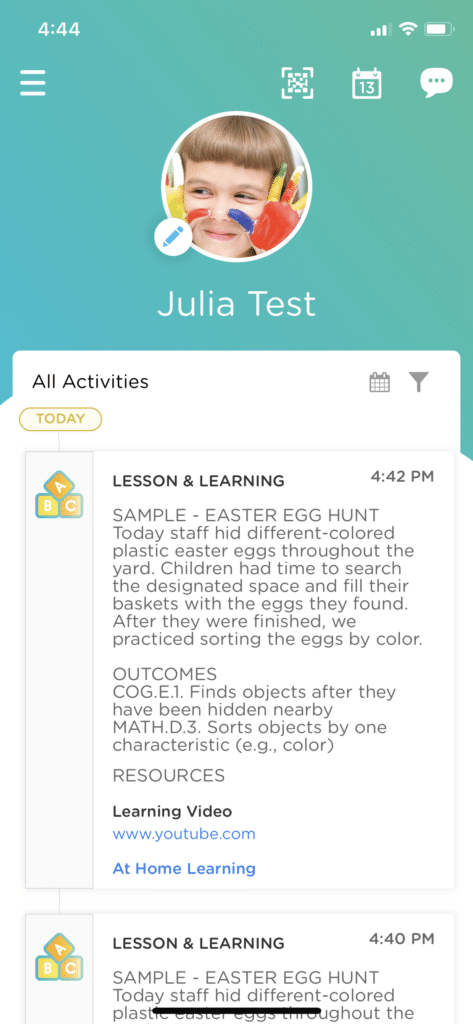
Handwriting is a necessary skill, even as technology continues to advance. Modern students are as likely to complete school work on a computer or tablet as a piece of paper. This trend will continue to grow in the coming years.
Still, handwriting is important for a number of reasons:
- Handwriting Improves Academic Performance: Studies show that students who learn handwriting skills at a young age achieve higher reading and spelling scores.
- Handwriting Enhances a Child’s Ability to Focus: Handwriting is difficult at first and requires a child’s full attention, forcing them to develop focus. Once they learn this valuable skill, they can shift their focus to conveying their thoughts via words.
- Handwriting Increases Critical Thinking Skills: The ability to think critically is one of the most important skills you can have. Without it, children won’t be able to make important decisions when they grow up. Handwriting hones critical thinking skills because writers have to think deeply to write coherently and prove their points.
- Handwriting is a Practical Life Skill: We don’t write things by hand as often as we used to. Still, handwriting is needed to write checks, sign documents, take notes and accomplish a wide variety of other tasks on a daily basis.
Handwriting is important. The question is, how do you teach it effectively at your child care center? We have some ideas!
Four Tips to Teach Handwriting at Your Daycare
You know you can’t just give your daycare students a pencil and a piece of paper and tell them to go for it. educate them so that they learn proper handwriting.
1. Help Kids Strengthen Their Fine Motor Skills
Fine motor skills are activities in which you use the small muscles in your hands and wrists to make precise movements. They’re different from gross motor skills like running and jumping, according to WebMD.
Activities you need fine motor skills to complete include tying one’s shoelaces, buttoning and unbuttoning one’s clothes, dialing a phone number, plugging a cord into a wall socket, putting keys into locks and turning door knobs.
Fine motor skills are also required when learning to write. Without well-developed hand muscles, children won’t be able to grip their pencils and maneuver them to create letters.
With that in mind, here are a few ways you can help kids strengthen their fine motor skills:
- Play With Play-Doh: The act of squeezing, stretching, pinching and sculpting Play-Doh will help your kids develop the muscles in their hands.
- Paint Pictures: Finger painting is a fun activity that gives kids the chance to get creative and develop manual dexterity. Painting with a brush will teach kids to control a tool, much like they’ll have to do when they write with a pencil.
- Take Kids to the Garden: Gardening requires both fine and gross motor skills. Activities such as digging with small trowels and planting seeds help develop the former, while also giving kids the opportunity to experience nature.
2. Understand Handwriting Development
Handwriting is a skill that’s developed over time. As such, it’s important to understand the various stages of handwriting so that you can help your kids through them.
Stage 1: Pre-Literacy

The first stage is known as the “preliterate” stage and usually happens before a child turns 2 years old. This is when children first start scribbling, typically with crayons, on blank pieces of paper and cardboard.. At this stage, simply make writing materials available and encourage young children to write and/scribble as often as possible.
Stage 2: Emergence
The second stage is known as the “emergent” stage and usually happens between the ages of 2 and 4. This is when toddlers begin writing random letters on pieces of paper. They might not understand what the letters mean, but they know that each letter means something. At this stage, teach toddlers how to write basic words to show them that letters have meaning. We also suggest reading out loud to your toddlers on a regular basis.
Stage 3: Transitioning
The third stage is known as the “transitional” stage and usually happens between the ages of 4 and 7. This is when kids begin to understand that every word is made up of sounds, and each letter represents a specific sound or two. As such, they’ll start trying to match the sounds they hear to the letters they know. At this stage, encourage your kids to write as often as possible — even if their spelling is hard to decipher. This is normal.
Stage 4: Fluency
The fourth stage is known as the “fluent” stage and usually happens when a child turns 5 or 6. This is when kids start to understand proper spelling and begin memorizing how certain words are spelled. Encourage your kids to write frequently at this stage.
3. Teach the Four Elements of Good Handwriting

Our next tip is to educate the kids in your early learning center about the four elements of good handwriting: pencil grasp, formation, legibility and pacing. Let’s take a closer look at each:
Pencil Grasp
Pencil grasp refers to the way a child holds his or her pencil.
Teach kids to use their index fingers and thumbs to hold their pencils against their middle fingers, as this has been proven to be the most effective pencil grasp technique.
If any of your kids have difficulty grasping their pencils in this way, consider giving them a pencil grip. This tool will help them grip their pencils in the manner outlined above, improving comfort and preventing hand fatigue while writing.
Formation
Formation refers to the way a child forms letters.
Since straight lines are easier to create than curved ones, we suggest teaching your kids to write capital letters before you teach them to write lower-case ones.
Also, be sure to teach kids the different sounds each letter makes while you show them how to draw each letter. This will help them connect sounds to shapes and learn to spell.
Legibility
Legibility refers to the readability of a child’s handwriting.
One of the easiest ways to improve handwriting legibility is to ensure there is enough space between words. This is why many teachers instruct kids to leave one finger space between every word they write. (Note: this technique doesn’t work well for left-handed students.)
We also suggest paying attention to letter size and slant when you teach handwriting, as these things can greatly affect legibility as well.
Pacing
Pacing refers to the speed at which a child writes.
As long as your kids grasp their pencils correctly and learn proper letter formation, improved pacing should develop naturally. But if a child becomes discouraged by their lack of writing speed, evaluate how hard they press their pencils to the paper when writing.
Pressing too hard can result in poor pacing, as well as increased hand fatigue. Ask your kids to write with multiple materials, such as pencils, markers and chalk. Doing so will help them assess their press and learn to adjust when necessary.
4. Get Creative When You Teach Handwriting
Finally, move beyond the pencil and paper when you teach handwriting — especially when working with young kids who don’t have well-developed fine motor skills yet.
What do we mean by this? Set up a finger painting station and ask your kids to form letters with their fingers. During cold months, ask kids to use their fingers to write letters in the condensation on your center’s windows. Give them access to your chalk or whiteboard.
Sometimes it’s easier for kids to write when they aren’t restricted to using a pencil and a piece of paper. So get creative and allow your kids to use alternative tools and surfaces.
Track Student Progress, and Share With Parents, With Procare!

It can be difficult to know when to teach handwriting to your daycare kids. How do you know if they’re ready to learn this important skill? A tool like Procare can help!
With Procare, you can easily check early learning standards for your state. That way you can track your students’ development in multiple areas, including handwriting. You can also use our software to create custom milestones for your child care center.
For example, you could create a custom milestone for each element of good handwriting discussed above: pencil grasp, formation, legibility and pacing.
Procare also allows you to create custom reports for every child in your care, based on your state’s early learning standards and/or the milestones you’ve chosen to track. Reports and lessons can then be shared with parents!
To learn more about Procare’s development tracking features, as well as our software’s other capabilities such as student attendance tracking, staff management and parent engagement tools, sign up for a free demo today!
Request a Demo
Request a demo and talk with one of our friendly Procare experts to get a tailored child care solution for the unique needs of your business.


